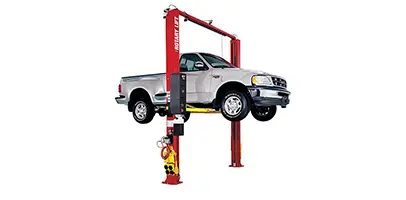
Troubleshooting 5 Common Automotive Lift Issues
Automotive Lift Issues
- Lift Won’t Come Down
- Air Blowing Out of the Air Compressor Valve
- Lift Arms Sinking or Sagging
- Safety Cable Not Working
- Lift is Bouncing
- Schedule Repairs Today
Keeping your automotive lift in good working condition is imperative not just for your shop’s production but also for the safety of your technicians and your customers’ vehicles. Most lifts require maintenance, including daily inspections of the cables, sheaves, sheave pins, locking latches, and compressed air supply, as well as monthly and quarterly maintenance and inspections.
When lifts aren’t properly maintained, it can cause a wide range of issues, so keeping them regularly maintained is essential. In this article, we’ll cover the five most common issues you’ll experience with lifts, how to troubleshoot each issue, and when it’s time to call a professional.
1. Lift Won’t Come Down
A lift that won’t come down could be caused by several factors, depending on the type of lift you have. Always check the hydraulic fluid level. If the lift has enough fluid, look for other issues.
Two-Post Lifts

A two-post lift may get stuck if you load the vehicle off-center. Ensuring you load the vehicle on-center prevents this issue. A two-post lift could also get stuck if the latches are engaging—they’ll need to be readjusted or replaced. Finally, if the cylinder orifice is plugged, loosen the cylinder bleeder slightly or loosen a line to lower the lift.
Four-Post Lifts

A four-post car lift may become stuck if:
- The latches are not adjusted correctly: In this situation, adjust the latches.
- If there’s a leak in the air line leading to the latches: The leak must be repaired.
- If the lift doesn’t have enough air pressure: Increase the air pressure.
- An air switch not releasing: Replace the air switch.
- An air latch cylinder that is stuck: Replace the latch cylinder.
- A bent slack cable latch: Replace the cable latch.
If you’re not comfortable getting the lift to come down, contact Allied, Inc. for help with repairs.
2. Air Blowing Out of the Air Compressor Valve

One of the common issues with automotive lifts is losing air (usually from the air compressor valve). If you’re sure where the air leak is, spray the valve with soapy water. When you do this, you’ll see bubbles form if there’s an air leak. Inspect the valve and connections for damage or wear. Tighten loose fittings or replace worn-out seals or fittings. If that doesn’t work, you may have to replace the valve.
3. Lift Arms Sinking or Sagging
If the lift arms are sagging or sinking, they may need new bushings. Other issues could include wallowed-out pin holes or worn pins. You can replace the bushings or have a professional bore holes and fit them with correctly sized pins.
4. Safety Cable Not Working
The safety cables are designed to prevent accidents and support the vehicle’s weight should the lifting mechanism fail. When these cables aren’t working correctly, you risk injury to yourself and the vehicle on the lift.
Always inspect the safety cables for wear, fraying, or other damage. Look for broken strands, rust, kinks, and corrosion. Replace the cables if you find any of these issues. Also:
- Check the Tension: Use a tension gauge to measure the tension of the cables. Adjust it when necessary.
- Inspect the Pulleys & Guides: Replace any pulleys or guides that are worn or otherwise damaged. Ensure they are properly aligned and that they rotate smoothly.
- Lubricate Moving Parts: Regularly lubricate the pulleys, guides, and cables to minimize wear.
5. Lift is Bouncing
A bouncing lift is a significant safety and functionality concern. A lift could bounce due to several issues with the hydraulic system, structural components, or air pressure.
If your lift is bouncing, try these troubleshooting tips first:
- Check the Hydraulic Fluid Levels: If the fluid is low or contaminated, it can cause bouncing. Add the recommended type of hydraulic fluid if it is low. If the fluid is discolored or contaminated, change the fluid.
- Bleed the Air: If air becomes trapped in the hydraulic system, it could cause bouncing. You can bleed the air in most lifts by raising the lift to its maximum height and then lowering it slowly. Repeat the process several times to allow the trapped air to escape through the hydraulic fluid reservoir.
- Check for Leaks: Check the cylinders and seals for leaks or damage. Replace the damaged components or seals. If you need to disassemble the cylinder, contact a professional.
- Inspect Mechanical Components: Check the cables, pulleys, and chains for wear and proper tension. If they are rusted, fraying, or otherwise damaged, replace them. Otherwise, adjust the tension. Make sure the pulleys are aligned and are rotating smoothly.
- Verify Air Pressure: Verify the air compressor is providing the correct pressure. Adjust the pressure when necessary and check for leaks.
Still Experiencing Issues? Schedule Repairs Today!
Founded in 1963, Allied, Inc. is a top U.S. supplier of Rotary automotive lifts. We also provide reliable repair and ALI-certified inspection services to shops across Michigan and Northern Ohio.
If you’re still experiencing issues with your lift, contact us today to schedule an appointment.
